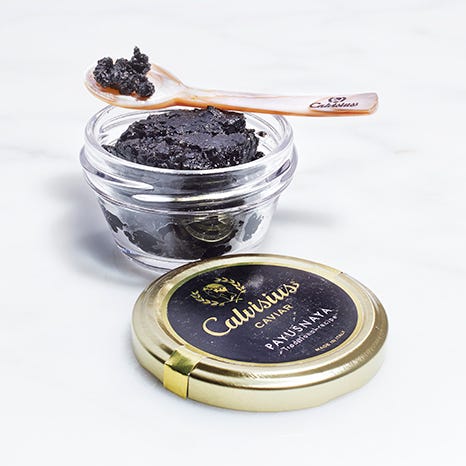How Much for 2 to Eat at Ruth's Chris
"Stop!" cried my mother the first time I tried caviar. She pried the tiny mother-of-pearl spoon from my greedy hand. "Leave some for the rest of us," she said reproachfully. "Do you have any idea what caviar costs?" I didn't. I was only 12, and to my enormous dismay it would be many years before caviar and I would meet again.
Fast-forward two decades. I had become the restaurant critic for the Los Angeles Times, a job that allowed me to eat anything, anywhere, anytime. In L.A., caviar graced almost every menu, and I joyfully renewed our acquaintance. Nothing had changed; I was still crazy about the glistening black pearls.
But in real life I was just a reporter with a modest salary. Caviar at home was out of the question. One day, as I stared at the caviar glittering in a Beverly Hills shop, the proprietor looked at my wistful expression and asked, "Have you ever tried pressed caviar?" I had never heard of the stuff.

Calvisius Lingotto Caviar
Shops and Restaurants calvisiususa.com
"Many caviar lovers," he said, opening a tin to reveal an inky black jam, "prefer this to ordinary caviar." I took a tiny, tentative bite and felt a thrill go through me. It was all here: the briny tang, the sweet nuttiness, the fruity, chocolate quality, only ramped up, and the pop of eggs had been replaced by a taffylike quality. Before the purveyor whispered the price—a fraction of the cost of the best beluga—I was hooked.
Pressed caviar (payusnaya in Russian) is traditionally made from the eggs that break during processing. Unwilling to waste them, Russian fishermen mixed the broken eggs together, heedless of the variety of sturgeon, turning them into a jam. Very little of the stuff ever made its way to market, and those who discovered the elixir tried to keep it to themselves.
The payusnaya club was not limited to bargain hunters; Aristotle Onassis preferred his caviar pressed. I can easily imagine him telling people, "You wouldn't like it."
I was happy with my newfound treat. I spread it on bread, I ate it splashed with lemon, I stirred it into pasta. Then, in 2005, the supply dried up. That was the year beluga sturgeon were deemed endangered and all imports containing beluga caviar from the Caspian and Black Sea basin were banned.

Don Penny
So imagine my delight when, last year, the Italian caviar company Calvisius hired Russian women to teach its artisans to craft payusnaya from the eggs of nonbanned sturgeon. Last year they introduced the product to Italy, and now they're bringing it to the U.S. They have also invented a denser, more intense version, called lingotto.
It takes several pounds of roe to make a single pound of it, but thinly sliced it makes any canapé look as if it's topped with black lace, and it's fantastic grated over pasta or scrambled eggs. Either way, pressed caviar is everything a caviar lover could want.
This story appears in the September 2019 Issue of Town & Country. SUBSCRIBE NOW
Ruth Reichl Contributing Editor Reichl is an award-winning writer and editor.
This content is created and maintained by a third party, and imported onto this page to help users provide their email addresses. You may be able to find more information about this and similar content at piano.io
How Much for 2 to Eat at Ruth's Chris
Source: https://www.townandcountrymag.com/leisure/dining/a28325922/pressed-caviar-payusnaya/